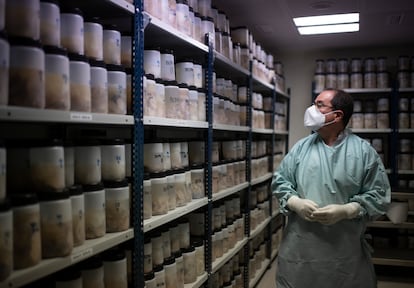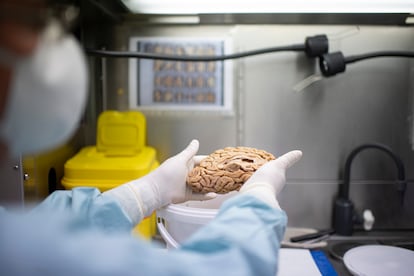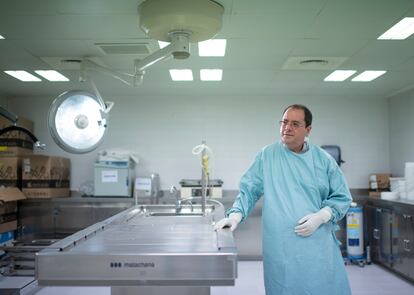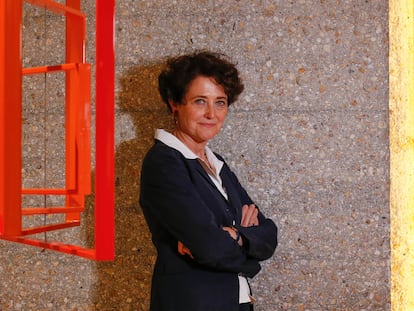The Alzheimer’s enigma: Why is the incidence falling at 16% a decade in the world’s richest countries?
While all experimental treatments have proven ineffective, science shows that the illness is not an inevitable tragedy of old age but a preventable disease in 40% of cases

The mind that created popular Spanish television shows Verano Azul and Farmacia de Guardia rests in formaldehyde in the Madrid neighborhood of Vallecas. During the final years of his life Antonio Mercero suffered from Alzheimer’s disease, but he continued to meet up with his old friends. One of these, the movie director José Luis Garci, recalled in an interview that one day Mercero told the group: “I find your stories funny, even if I don’t know who you are. But I do know that I love you all very much.” Mercero died in 2018 at the age of 82 after a decade with dementia and donated his brain to science. He wanted his gray matter to help shine a light on what has become known as the “great silent epidemic of the 21st century.”
Pathologist Alberto Rábano walks among brains with respect and affection, as though he knows them all. Rábano is the director of the CIEN Foundation Tissue Bank, which contains more than a million donated organs – including Mercero’s contribution – that are used in the investigation of neurological diseases. Rábano’s work is centered on a huge paradox: more than a hundred years after Alzheimer’s disease was identified, its causes are still unknown and there is no effective treatment. And yet, incidence of the illness is plummeting in the world’s richest countries at a rate of 16% every decade since 1988, possibly due to factors such as education and cardiovascular health according to a study from Harvard University.
“We do not know the cause of Alzheimer’s and we never will, because there is no one cause, there are many,” says Rábano. Until now, researchers have focused on two prime suspects. In the brains of Alzheimer’s patients, a protein called amyloid beta accumulates among the neurons. And a second protein, tau, forms balls inside the brain cells. However, in the words of neurologist David Pérez of Madrid’s Hospital 12 Octubre, thinking that these proteins are responsible for Alzheimer’s is like arriving at the scene of a crime and believing the blood committed murder.

The search for a treatment, however, has been centered on cleaning the amyloid beta from the brain. All experimental drugs employed until now have failed, but on June 7 the US health authorities approved the most recent, aducanumab, produced by US pharmaceutical company Biogen with a cost of over $40,000 a year per patient. It is the first time a drug that attacks the suspected causes of Alzheimer’s has received approval from the Food and Drug Administration (FDA): aducanumab targets aggregated forms of amyloid beta but is has not yet been proven that this implies clinical benefits for patients. It is still unknown if the treatment works.
Rábano pauses among a set of shelves that break the monotony of the bank of brains. “This is from a sea lion that used to perform in a show at the Madrid Zoo dressed as a cowboy,” he says. “This one is from a white rhinoceros. I had to take it out with an axe,” says Rábano, pointing to another recipient. Brains from animals that have died of old age at the zoo also end up at the CIEN. Among the collection are lions, dolphins, koalas, wildebeest, chimpanzees and giraffes. The researcher displays an image of a Siberian tiger brain, full of amyloid beta. “We have seen changes similar to Alzheimer’s in many mammals, but the disease never develops,” Rábano explains.
The pathologist believes that one of the historical reasons the search for a treatment has been unsuccessful is diagnostic errors. “Alzheimer’s is never alone. We have to implant the idea in our heads that it is not enough to diagnose Alzheimer’s.” There are 50 million people worldwide with dementia and of these 65% have Alzheimer’s, according to the World Health Organization (WHO). But there are other forms of dementia that are often mixed together: vascular dementia, dementia with Lewy bodies (DLB), tauopathy, limbic-predominant age-related TDP-43 encephalopathy (LATE). Some clinical trials are unsuccessful possibly because Alzheimer’s drugs are being tested in people who do not only have Alzheimer’s. Rábano invites people to become brain donors, to aid in the research.

Neurologist Raquel Sánchez Valle of the Hospital Clínic Barcelona, is optimistic. “We have entered a new phase in Alzheimer’s investigation,” she says. Sánchez’s team worked on the Engage trial, a Phase 3 study of aducanumab involving 1,650 patients worldwide. The results were inconclusive but Sánchez points out that the elimination of the amyloid beta protein in the brain did improve the indicators associated with the death of neuronal cells, although this did not lead to observation of a clear overall improvement in the patients. “We need longer trials, much longer,” she says.
Aducanumab is a monoclonal antibody: the natural defenses of a lucid senior citizen multiplied in the laboratory. Sánchez notes that in the next two years results from trials of three similar experimental drugs will be forthcoming: gantenerumab (produced by Swiss company Roche), donanemab (from US firm Lilly) and lecanemab (developed by Japan’s Eisai). “We cannot expect to go from having nothing to finding a cure of Alzheimer’s. Aducanumab is a first step. And a lot of the time the first drug to arrive is not the drug that lasts the course,” Sánchez says.
Other researchers are more skeptical. Neurologist Michael Greicius, who directs the Stanford Center for Memory Disorders, believes the approval of aducanumab could even lead to obstructions in the investigation of other treatments. “Patients are less willing to participate in clinical trials if they are already taking a new approved drug that they think works,” he notes. Greicius also points out that aducanumab led to cerebral edemas in 40% of patients treated with a high dose.
Joaquina García del Moral, a retired teacher from Motril (Granada), was one of the patients in another global-scale trial called Emerge, also with 1,650 participants. Surprisingly, while the Engage trial did not witness clinical improvement in participants, in the Emerge trial a 20% deceleration in cognitive deterioration was observed. García del Moral, 66, was diagnosed with Alzheimer’s when she was 59. “I forgot the names of my pupils and I would get lost while driving or walking,” she recalls. “After five years of treatment with aducanumab I lead a normal life and I feel able to do everything. It has changed my life; I don’t know if this [treatment] is debatable. I’m not a scientist.”
Her neurologist, Eduardo Agüera, does leave the door open to other explanations. “Joaquina’s improvement is most likely attributable to aducanumab, but there is no 100% certainty.” Agüera, a cognitive pathology specialist at Córdoba’s Hospital Reina Sofía, also asks that the drug be given some leeway. “If the alternative is that there is nothing and people are left to slowly die with dementia, and if with aducanumab there is a glimmer of hope, then fantastic.”
Joaquina García del Moral is a member of the Panel of Experts of People with Alzheimer’s, created by the Spanish Alzheimer’s Confederation (CEAFA), which is pushing for the approval of aducanumab in the European Union. “This drug has to made available in Europe come what may. There are many millions of us who need this treatment,” she says.

CEAFA president Cheles Cantabrana says the organization was “delighted” when aducanumab was approved in the US. “The suffering Alzheimer’s inflicts on families is considerable and the costs are enormous. There are millions of people suffering. Are we going to give them a chance or are they second-class patients?” asks the sociologist, whose parents died with dementia. CEAFA estimates that there are five million people affected by Alzheimer’s in Spain, taking into account patients and family care-givers.
The European Medicines Agency (EMA) is currently studying the results of aducanumab to evaluate its possible authorization in the EU. And this will lead to inevitable controversy, according to César Hernández of the Spanish Agency of Medicines and Medical Devices. “This is a debate that will create a lot of discussion in Europe. There is a lot of controversy over whether the amyloid beta plaques genuinely reflect the advance of the disease,” he says. Of the 104 experimental drugs that are being tested worldwide to counter the possible causes of Alzheimer’s, 16 are centered on the amyloid beta protein and 11 on the tau protein.
In protest against the approval of aducanumab in the US, three experts resigned from an independent committee that advises the FDA. Neurologist David Knopman, of the Mayo Clinic, was one of them. Before resigning, he had said it was “indefensible” to approve a drug with no proven clinical benefits after 18 months of treatment. “In many aspects we are winning the war against Alzheimer’s, but in such a long-term struggle we are not going to win every battle,” Knopman notes.

In recent years Knopman has focused on “the enigma of the declining incidence of dementia.” The overall number of dementia cases is on the rise, due to the increase in life expectancy and the fact there are a greater number of old people, but the percentage of people with Alzheimer’s is decreasing. In autopsies conducted on donated brains fewer accumulations of the amyloid beta protein are being recorded. In the most developed countries, where there is an obsession with finding a cure for Alzheimer’s, there has been a 16% decrease in the disease’s incidence decade-on-decade since 1988.
A commission organized by medical journal The Lancet last year calculated that modifying a dozen risk factors could prevent or delay dementia in 40% of cases. These 12 variables are lack of education, hypertension, auditive disability, smoking, obesity, depression, lack of physical activity, diabetes, social isolation, excess consumption of alcohol, blows to the head and atmospheric contamination. In Latin America, according to the study, the percentage of preventable cases of dementia reaches 56%.
Antonio Mercero directed a movie about Alzheimer’s in 2007 - ¿Y tú quién eres? (or, And who are you?) – before he was diagnosed with the disease. At the premiere he stated: “It’s incredible. Right now anyone can tell you they have a cousin with Alzheimer’s, or an uncle, or a father. It’s a terrible thing. Alzheimer’s is everywhere now.” The WHO estimates that the number of people with dementia will triple to over 150 million by 2050. Eliminating risk factors could prevent 40 million cases without the need for any miracle drug. Sánchez Valle believes furthermore that a treatment will arrive sooner rather than later. The countries of the G7 made a commitment eight years ago to develop a cure or an effective treatment for dementia by 2025. “We will not have a cure in 2025, but I do hope to see an effective treatment before I retire,” says Sánchez, 50. “And it won’t be aducanumab.”
English version by Rob Train.
Tu suscripción se está usando en otro dispositivo
¿Quieres añadir otro usuario a tu suscripción?
Si continúas leyendo en este dispositivo, no se podrá leer en el otro.
FlechaTu suscripción se está usando en otro dispositivo y solo puedes acceder a EL PAÍS desde un dispositivo a la vez.
Si quieres compartir tu cuenta, cambia tu suscripción a la modalidad Premium, así podrás añadir otro usuario. Cada uno accederá con su propia cuenta de email, lo que os permitirá personalizar vuestra experiencia en EL PAÍS.
¿Tienes una suscripción de empresa? Accede aquí para contratar más cuentas.
En el caso de no saber quién está usando tu cuenta, te recomendamos cambiar tu contraseña aquí.
Si decides continuar compartiendo tu cuenta, este mensaje se mostrará en tu dispositivo y en el de la otra persona que está usando tu cuenta de forma indefinida, afectando a tu experiencia de lectura. Puedes consultar aquí los términos y condiciones de la suscripción digital.
More information
Archived In
Últimas noticias
Most viewed
- Oona Chaplin: ‘I told James Cameron that I was living in a treehouse and starting a permaculture project with a friend’
- Reinhard Genzel, Nobel laureate in physics: ‘One-minute videos will never give you the truth’
- Sinaloa Cartel war is taking its toll on Los Chapitos
- Why the price of coffee has skyrocketed: from Brazilian plantations to specialty coffee houses
- Silver prices are going crazy: This is what’s fueling the rally











































